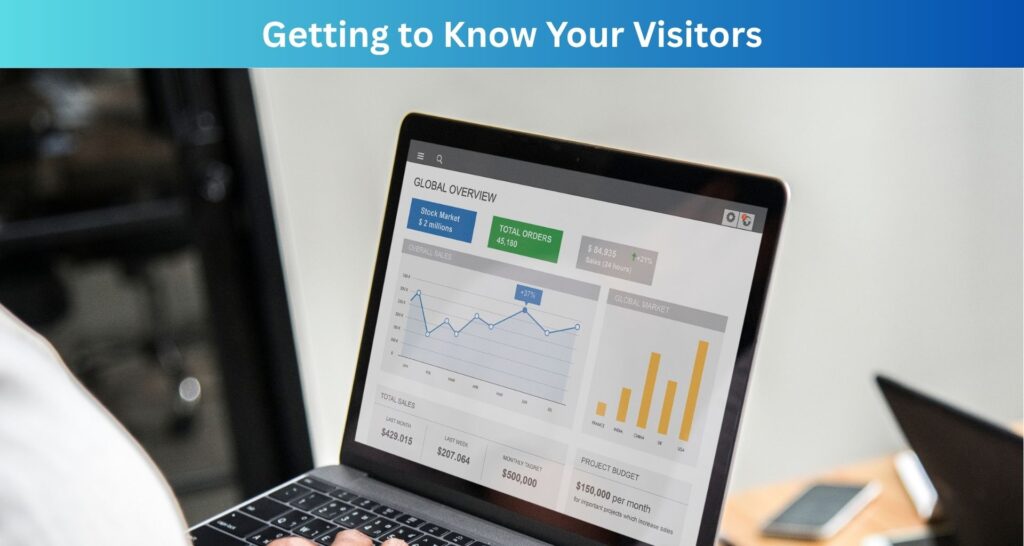
How Can Businesses Benefit from Using Analytics on Their Website?
Having a website today is like having a shop in the busiest part of town. People pass by, some stop to look, some browse for a while, and some make a purchase. But here’s the big difference: in a physical shop, you can see your customers, watch their behavior, and talk to them directly. On a website, that’s not possible unless you have the right tools.
This is where website analytics comes in.
Website analytics is the process of collecting and analyzing data about how people use your site. It tells you who your visitors are, where they come from, what they do on your pages, and why they leave. With this information, you can make your website more useful, more appealing, and more profitable.
Let’s dive deeper into how businesses can benefit from using analytics on their website.
1. Getting to Know Your Visitors
In the offline world, a shop owner can easily observe their customers notice what they pick up, hear the questions they ask, and even have casual conversations to understand their needs. But on a website, you don’t see faces or hear voices. Without the right tools, it’s like running a store with the lights off people might come and go, but you have no idea who they are or what they want.

This is where website analytics becomes your eyes and ears. It collects valuable information about your visitors and turns it into easy-to-understand insights.
With tools like Google Analytics, you can find out:
- Where they are located – You can see if most of your visitors are from a particular country, state, or even city.
- What devices they use – Whether they prefer browsing your site on a smartphone, tablet, or desktop.
- How they found you – Did they click a link on social media, search for something on Google, respond to an advertisement, or come directly to your site?
Knowing these details can completely change how you run your online business.
Example:
Imagine you own an online clothing store. Without analytics, you might spend equal effort promoting all kinds of products summer t-shirts, monsoon raincoats, and winter jackets. But analytics might reveal that 70% of your visitors are from colder regions. Suddenly, you have a clear direction showcase jackets, sweaters, and warm accessories on your homepage, run winter-wear promotions, and even write blog posts about “How to Layer Clothes in Cold Weather.”
The result? Visitors feel like your store understands their needs, making them more likely to buy from you.
Simply put, analytics removes the guesswork. Instead of making blind assumptions about your customers, you start making decisions backed by facts and that’s how you turn casual visitors into loyal customers.
2. Seeing What People Do on Your Site
Knowing who visits your website is important but it’s only half the story. The real magic happens when you understand what those visitors actually do after they land on your site. This is where analytics works like a digital security camera, recording the “footsteps” of your visitors so you can see their journey in detail.
With website analytics, you can discover:
- Which pages are the most popular – Maybe your homepage gets the most visits, or perhaps a specific blog post is drawing huge attention.
- How much time visitors spend on each page – Do they read the whole article or leave after a few seconds?
- The path they follow through your site – Do they go from your homepage to your product pages, or do they jump straight to your blog and then exit?
This information is gold because it shows you what’s working and what isn’t.
Example:
Let’s say you run a travel blog. You might find that your post “Top 10 Budget Travel Tips” keeps people reading for a full five minutes, while your “Luxury Resorts” article barely holds attention for 30 seconds. This tells you something important: your audience is far more interested in saving money than in reading about expensive stays.
Armed with this insight, you can focus on creating more budget-friendly travel guides, destination reviews, and money-saving tips exactly the kind of content your readers want.
By tracking what people do on your site, you stop guessing and start shaping your content, layout, and offers around real visitor behavior. Over time, this makes your website more relevant, more engaging, and more likely to turn casual readers into loyal fans or paying customers.
3. Fixing Problems Before They Cost You Customers
Not every visitor leaves your website because they’re uninterested in what you offer. Sometimes, they leave because something on your site makes their experience difficult or frustrating. Unfortunately, these issues aren’t always visible to you but they can be painfully obvious to your visitors.
Website analytics works like a silent inspector, helping you identify and fix problems before they scare away potential customers.
Some common issues analytics can uncover include:
- Slow loading speed – If your page takes more than a few seconds to load, people will click away without giving it a chance.
- Broken links – A link that leads to an error page makes visitors feel lost and disappointed.
- Poor mobile display – If your site isn’t mobile-friendly, visitors using phones or tablets will have a hard time navigating.
Example:
Imagine a customer clicks on your ad for a new product, but when the page opens, it takes 10 seconds to load. By the time it appears, the customer has already closed the tab. Analytics could reveal this slow load time, allowing you to fix it before you lose more sales.
When you use analytics to find and solve these problems, you create a smoother, more enjoyable browsing experience. Visitors can explore your content without interruptions, making them more likely to stay longer, trust your brand, and eventually make a purchase.
Also read :
https://www.cloudflare.com/learning/performance/more/website-performance-conversion-rates
In short, fixing technical issues isn’t just about improving your website it’s about protecting your sales, your reputation, and your customer relationships.
4. Making Better Business Decisions
Running a business without data is like sailing a ship without a compass you might move forward, but you won’t always be headed in the right direction. Guessing what your customers want or where to spend your marketing budget can be risky and expensive. That’s why analytics is so valuable it replaces guesswork with real, reliable information.
When you track and study your website data, you can see exactly what’s working and what’s not. This helps you make smart choices that actually lead to growth.
Here’s how analytics can guide your decisions:
- Highlight what sells the most – If one product page brings in the highest sales, you can feature it on your homepage or promote it more in ads.
- Cut what doesn’t perform – If a marketing channel (like a specific social media platform or ad campaign) brings visitors but no sales, you can stop wasting money on it.
- Plan around peak seasons – If your analytics show a spike in visitors during certain months, you can schedule special promotions or launches during that time for maximum impact.
Example:
Let’s say you run an online bakery. Analytics shows that your “Chocolate Fudge Cake” page gets the most orders, while “Vanilla Cupcakes” barely sell. You could make the fudge cake a featured product, run a “limited-time discount” on it, and advertise it more heavily. At the same time, you might choose to spend less time and resources on the cupcakes.
By making data-driven decisions, you save money, reduce wasted effort, and focus on strategies that truly deliver results. Over time, this creates a business that runs more efficiently and earns more profit without unnecessary trial and error.
5. Improving Marketing Campaigns
Marketing is one of the biggest investments a business makes and also one of the trickiest to get right. You can spend thousands of rupees (or dollars) on ads, social media posts, and promotions, but if you don’t know which ones are actually working, you might be wasting money without realizing it.
This is where analytics becomes your marketing guide. It helps you track the performance of every campaign, so you know exactly where your time and money are giving the best returns.
With website analytics, you can see:
- Which ads bring the most visitors – This tells you where your advertising is paying off and where it’s falling flat.
- Which social media platforms work best – You might discover that Instagram brings far more engaged visitors than Facebook, or that LinkedIn works better for your industry.
- Which keywords attract people to your site – Knowing the exact words people type into search engines helps you fine-tune your SEO strategy and create content they’re already looking for.
Example:
Imagine you run an online fitness store and invest in ads on both Instagram and Facebook. Analytics shows that your Instagram ads bring 1,000 visitors per month, while Facebook ads only bring 200. That’s a clear signal to shift more of your ad budget to Instagram, where you’re reaching a bigger and more interested audience.
When you continuously measure and adjust your campaigns based on analytics, you make sure that every marketing dollar is spent wisely. Over time, this not only increases your reach but also improves your conversion rates — meaning more sales for the same budget.
6. Increasing Conversions
Getting visitors to your website is only the first step. The real goal is to turn those visitors into customers, subscribers, or leads and that’s what we call a conversion. A conversion can be anything you want your visitors to do: buying a product, signing up for your newsletter, booking a service, or even downloading a free guide.
But here’s the challenge: not everyone who visits your site completes the action you want. Some leave halfway through the process and that’s where analytics becomes your detective.
With analytics, you can see exactly where and when people are dropping out:
- Do they abandon their shopping cart before checkout?
- Do they start filling out your contact form but stop midway?
- Do they look at your pricing page but never click “Buy Now”?
Also Read :
Top 20 Conversion Rate Optimization Tips to Increase Your Website Conversion Rate
These insights help you understand what’s getting in their way.
Example:
Let’s say you run an online gadget store. Analytics shows that 40% of your customers add items to their cart but leave before paying. After digging deeper, you find that high shipping costs are causing them to change their mind. You decide to offer free shipping on orders above a certain amount, and suddenly your checkout completion rate improves.
By removing obstacles such as long forms, confusing navigation, or hidden fees you make the buying process smoother and more inviting. This keeps visitors moving toward that final click, whether it’s a “Purchase,” “Subscribe,” or “Contact Us” button.
In short, analytics doesn’t just tell you how many people visit your site it helps you understand how to turn those visits into meaningful actions that grow your business.
7. Staying Ahead of Competitors
In today’s fast-moving digital world, customers’ interests can change overnight. One week, everyone is searching for a new trending product, and the next, their attention shifts somewhere else. In such a competitive market, the businesses that can adapt quickly are the ones that win.
Website analytics gives you the power to spot these changes early often before your competitors even notice them. By studying your data, you can identify patterns, trends, and shifts in customer behavior that help you make timely moves.
For example, analytics might reveal:
- A sudden spike in interest for a specific product – Maybe people are searching for “eco-friendly water bottles” more than usual.
- A shift in demand from one service to another – You might notice that fewer visitors are checking your “in-person workshops” page but more are exploring your “online courses” section.
- Seasonal changes in customer needs – Like an increase in searches for winter clothing during October or travel deals during summer holidays.
Example:
Imagine you own an online electronics store. Your analytics shows a sharp increase in searches for “wireless earbuds” over the past two weeks. If you act quickly, you can highlight these products on your homepage, run special offers, or create blog posts comparing different earbud models. While you’re already meeting customer demand, competitors who rely on guesswork might still be promoting older or less popular items.
By staying alert to these signals, you can respond faster, attract more customers, and maintain a lead in the market. In business, timing can be everything and analytics helps you be in the right place at the right time.
8. Building Customer Loyalty
In business, getting a customer for the first time is an achievement but getting them to come back again and again is where true long-term success lies. Returning visitors are often more valuable than new ones, because they already know and trust your brand. They’re more likely to buy from you again, spend more per purchase, and even recommend you to others.
Website analytics can help you uncover the secrets behind why people return to your site. By studying the data, you can see patterns in their behavior and understand what keeps them engaged.
For example, analytics can reveal:
- Content they love – Do they return every time you post a new blog article, tutorial, or video?
- Special offers that work – Do they visit more often when you run seasonal sales or exclusive promotions?
- Features that keep them hooked – Do they spend more time on your site after you introduce new tools, product lines, or improved designs?
Example:
Imagine you run an online recipe website. Analytics shows that many visitors return every Saturday morning the same day you upload your “Weekly Meal Plan.” Knowing this, you could make that content a regular, well-promoted feature, ensuring people have a reason to visit week after week.
By identifying and doubling down on what keeps your audience coming back, you strengthen relationships, build trust, and turn casual visitors into loyal fans. Over time, these loyal customers become the backbone of your business, providing steady revenue and helping you grow through word-of-mouth recommendations.
9. Saving Time and Money
No matter the size of your business, one truth remains the same time and money are limited. Wasting either on the wrong activities can hold back your growth. That’s where website analytics becomes a game-changer.
Instead of guessing what might work, analytics shows you exactly where your efforts pay off and where they don’t. This means you can stop pouring resources into things that aren’t delivering results and focus on what actually moves the needle.
For example, analytics can help you:
- Cut out wasted effort – If you notice certain blog posts get almost no traffic, you can stop spending time creating similar content.
- Prioritize high-performing channels – If your email campaigns bring more sales than paid ads, you can invest more in email and scale back on ads that underperform.
- Invest in the right products and services – If your data shows one product sells far better than others, you can focus marketing and inventory on that winner.
Example:
Imagine you own a handmade jewelry store. Analytics reveals that your “Silver Charm Bracelets” page gets ten times more sales than your “Gold Earrings” page. Instead of spreading your budget evenly across all products, you could put more advertising behind the bracelets, run bundle offers, and even create new bracelet designs to match demand.
By letting analytics guide your decisions, you save time, spend money more effectively, and maximize your return on investment. In short, you work smarter, not harder and your bottom line thanks you for it.
How to Start Using Website Analytics
Starting with website analytics might sound complicated, but it’s actually much simpler than most business owners think. You don’t need to be a tech expert you just need a clear goal, the right tool, and a habit of checking your data regularly.
Here’s a straightforward guide to get you started:
- Set clear goals – Before you look at any numbers, decide what you want to achieve. Are you aiming for more sales? More newsletter sign-ups? Or maybe you want visitors to spend more time on your site? Your goals will guide the kind of data you focus on.
- Choose the right tool – For beginners, Google Analytics is a great starting point because it’s free, powerful, and widely supported. As you grow, you might explore other tools like Adobe Analytics for more advanced features.
- Install the tracking code – Once you pick your tool, you’ll get a small piece of code to place on your website. This code works quietly in the background, collecting information about your visitors and their actions.
- Check your data regularly – Make it a habit to review your analytics weekly or monthly. This helps you spot patterns early, such as rising interest in a product or a sudden drop in traffic from a certain source.
- Test, adjust, and improve – Use what you learn to make changes. If a page is performing well, promote it more. If another page has high drop-off rates, tweak it to improve engagement. Then check your data again to see if your changes worked.
Watch This For Start With Google Analytics :
Tip: Start small. You don’t need to track everything at once. Pick a few key metrics that align with your goals, and expand your tracking as you get more comfortable.
By following these steps, you’ll move from making decisions based on guesses to making them based on real, actionable insights and that can make a world of difference for your business.
Common Mistakes to Avoid
Website analytics can be incredibly powerful but only if you use it the right way. Many businesses collect plenty of data but fail to turn it into meaningful action. Here are some common pitfalls to watch out for (and how to avoid them):
- Ignoring mobile visitors
In today’s world, a huge portion of your traffic likely comes from smartphones and tablets. If you only focus on desktop users, you’re missing a big piece of the puzzle. Analytics can show you how mobile visitors behave from the devices they use to the problems they face. If your site loads slowly or looks awkward on a phone, you could be losing sales without even realizing it. - Tracking everything under the sun
It’s tempting to measure every possible number your analytics tool offers. But tracking too much can overwhelm you and distract from what really matters. Instead, focus on a few key metrics that directly relate to your goals such as sales conversions, bounce rate, or top traffic sources. Quality insights beat quantity every time. - Not acting on the data
Data on its own is just numbers. The real value comes when you use it to make improvements. If you see that a product page has high traffic but low sales, don’t just note it fix it. Maybe the description needs to be clearer, the images more appealing, or the checkout process smoother.
Frequently Asked Questions
1. Is website analytics only for large businesses?
No – even small businesses can benefit. Understanding your audience helps you grow, no matter your size.
2. Does analytics slow down my website?
No. When installed correctly, analytics tools work in the background without affecting speed.
3. Is Google Analytics free?
Yes. Google Analytics offers a free version that’s powerful enough for most businesses.
Final Thoughts
So, how can businesses benefit from using analytics on their website?
By using analytics, businesses can truly understand their audience, fix problems that drive customers away, make smarter decisions, improve marketing, increase conversions, and build loyalty.
In short, analytics turns your website from just an online presence into a tool for real growth. Without it, you’re guessing in the dark. With it, you’re making decisions with confidence and that’s how businesses succeed in the digital age.
Thanks For Visiting primehighlights.com



